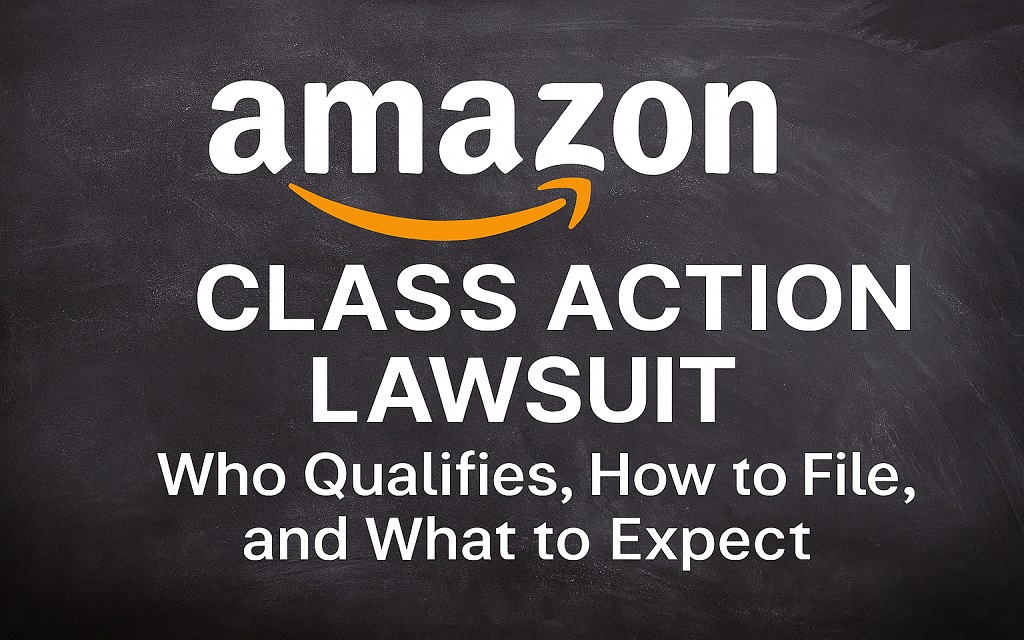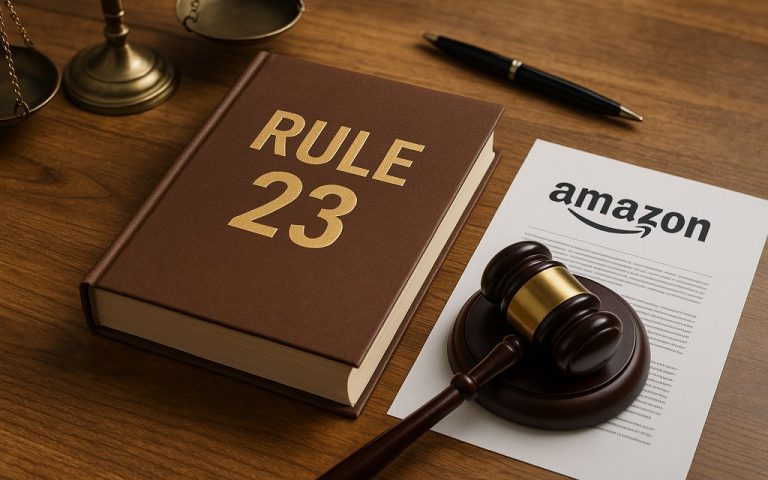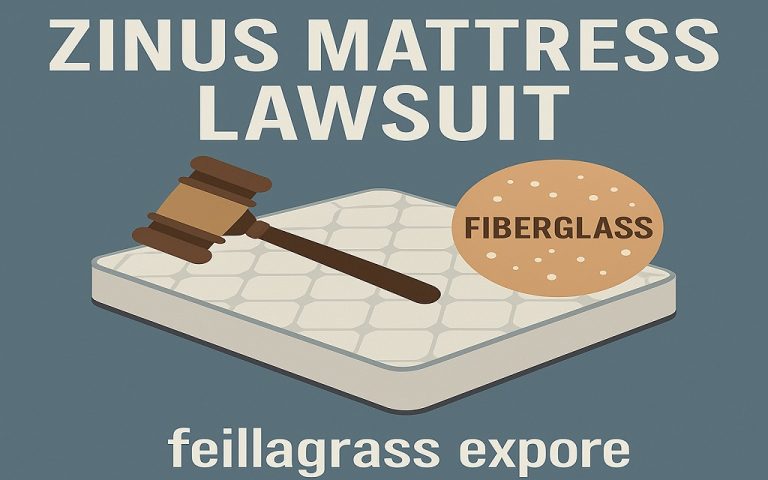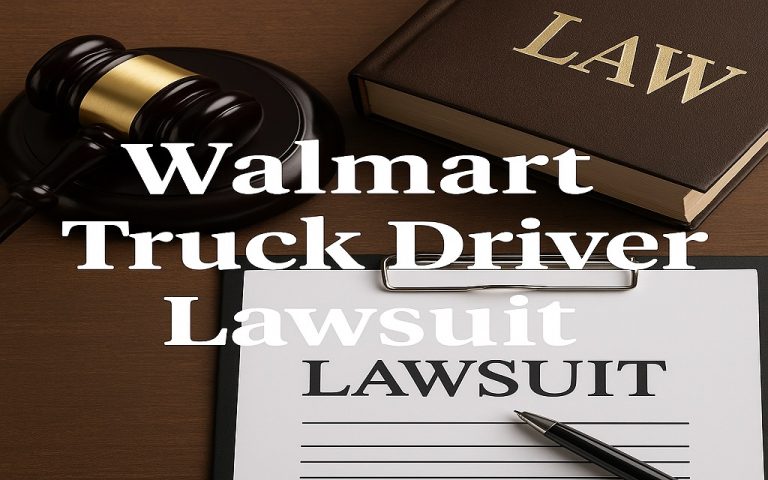The Amazon Class Action Lawsuit is making headlines—and it could put money back in your pocket. You might be impacted whether you’ve worked as a Flex driver, sold goods on Amazon, or shopped there.
Everything you need to know about the current Amazon Class Action Lawsuit is covered in this guide, including who is eligible, how to submit a claim, and what settlement payouts to anticipate.
The Amazon Class Action Lawsuit may affect you, whether you’re worried about underpaid wages, privacy issues, or exorbitant costs. Continue reading to see how these court cases are changing Amazon’s business practices and how you stand to gain.
What Is the Amazon Class Action Lawsuit?
Amazon is accused of using anticompetitive practices that harmed American consumers in a class action complaint. Amazon’s pricing strategy for third-party sellers, which purportedly prevented them from offering lower rates on other platforms, is at the center of the dispute. The result? Unbeknownst to them, shoppers may have overpaid for millions of things.
The Western District of Washington is where the main lawsuit, De Coster v. Amazon.com Inc., was filed. Judge John Chun certified a nationwide class on August 30, 2025, allowing the case to proceed as a single lawsuit. Almost 288 million American customers who bought five or more new products from Amazon’s third-party merchants between May 26, 2017, and the present are included in this class.
The plaintiffs argue that Amazon’s former “most-favored-nation” rule forced sellers to maintain high prices across the internet. Critics claim that the impact of this policy persisted even after Amazon discontinued it in 2019 because seller agreements still included similar limits.
Although distinct, this class action is closely related to Amazon’s larger antitrust investigation. In a trial set for February 2027, the Federal Trade Commission (FTC) also filed a lawsuit against Amazon for algorithm-driven pricing hikes.
Key facts:
- Lawsuit filed in 2021
- Targets Amazon’s pricing restrictions on sellers
- Covers purchases made through the Buy Box
- Class includes 288 million U.S. shoppers
- Class period begins May 26, 2017
- Amazon has appealed the class certification ruling
This case may become one of the most significant class actions in U.S. legal history—both in terms of participants and potential damages.
Do Antitrust Claims Target the Amazon Buy Box?

Yes. The lawsuit directly targets how Amazon’s Buy Box algorithm interacts with seller pricing policies. The plaintiffs claim Amazon pressured sellers to maintain price parity across the web—especially if they wanted to win the Buy Box.
Here’s how the Buy Box works: it’s the default “Add to Cart” or “Buy Now” option on most Amazon product pages. Sellers who follow Amazon’s terms—often including pricing restrictions—get a better chance of landing this premium spot. If they list cheaper prices on other platforms (like Walmart or eBay), Amazon can suppress their visibility or make their listings harder to find.
This system allegedly:
- Inflated prices across the internet
- Hurt consumers who unknowingly paid more
- Reduced competition among marketplaces
Though Amazon ended its “price parity” policy in 2019, the lawsuit argues its effects persisted through indirect means. The Buy Box system still favors sellers who follow Amazon’s pricing preferences, according to court filings.
The FTC has made similar claims in its own antitrust suit. That case alleges Amazon used pricing algorithms and penalties to keep competitors from undercutting it, causing consumers to pay over $1 billion more in total.
In the De Coster lawsuit, the Buy Box plays a central role in how Amazon allegedly maintained its market dominance and suppressed competitive pricing.
Must Read: Class-Action Lawsuits: A Complete Guide to Legal Collective Action
Who Can Join the Amazon Class Action Right Now?
If you live in the U.S. and bought at least five new items from third-party sellers on Amazon since May 26, 2017, you may already be included in the class automatically.
This class action uses the “opt-out” system. That means:
- You don’t need to do anything now to join.
- You’re part of the class unless you opt out when the court sets a notice deadline.
- If the class wins or settles, you’ll be eligible for a payout.
The class was certified by a judge in late August 2025. It includes:
- All U.S. consumers
- Who bought five or more new items
- From third-party sellers on Amazon.com
- Between May 26, 2017, and the final resolution
Amazon has already appealed this ruling, but unless overturned, the class definition will likely stand.
If you meet the criteria, keep an eye out for:
- Official class notices (email or mail)
- Opt-out deadlines
- Claim submission portals, once a settlement or judgment occurs
Important note: At this point, neither a receipt nor your login history is required. However, if a payout occurs later, evidence of purchase (such as order numbers and email confirmations) can be helpful.
How Do Courts Handle Class Actions Against Amazon?
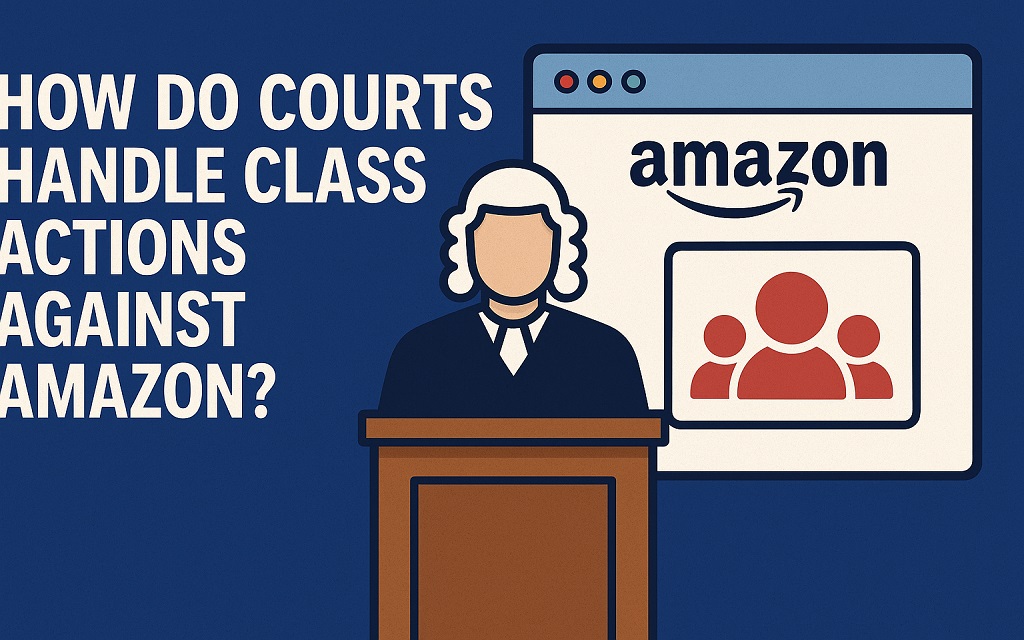
Amazon class actions follow the typical path used in ample consumer protection and antitrust cases:
1. Complaint & Filing (2021)
Citing contract interference, consumer overcharging, and monopoly practices, the plaintiffs filed the complaint in federal court in Seattle.
2. Dismissal Motions
Amazon argued that its seller policies were lawful, pro-consumer, and harmless in an effort to have the case dismissed. The judge allowed key claims to proceed.
3. Certification of the Class (August 2025)
The plaintiffs asked the court to certify a class of people across the country. In agreement, Judge John Chun decided that the class was sizable but still controllable under federal law. Amazon argued against certification, pointing to the breadth and depth of customer experiences.
4. Revision (September 2025)
Amazon filed an appeal against the certification decision. Whether the matter can proceed as a class action will be determined by the Ninth Circuit.
5. Settlement or Trial (TBD)
If upheld, the case moves toward trial. Amazon could also settle—especially given the size of the class and potential damages.
This class action could take years to resolve. Similar antitrust cases often involve:
- Expert witnesses
- Massive data discovery
- Complicated damage models
And it’s not the only one. This is part of a broader legal dispute against Amazon’s business model, as the FTC, state attorneys general, and individual sellers are suing the company in parallel.
What Evidence Supports Monopoly or Tying Theories?
The plaintiffs claim that Amazon imposed anti-competitive terms on third-party vendors, particularly regarding price control, by abusing its platform dominance.
Key arguments:
- Amazon holds monopoly power in the U.S. online retail market.
- It required sellers to refrain from offering lower prices on competing platforms.
- This “tying” condition linked Buy Box access to compliance with price parity rules.
- Even after dropping the explicit clause in 2019, Amazon’s enforcement of seller terms continued to maintain the same economic outcome.
Economic experts cited in court filings claim:
- Amazon’s policies reduced price competition across the internet.
- Consumers paid artificially high prices on Amazon and elsewhere.
- Amazon’s market share and fee structures allowed it to extract supra-competitive profits.
Amazon counters these claims by arguing:
- It competes with hundreds of retailers.
- Sellers are free to list elsewhere.
- Its rules benefited consumers by ensuring consistent experiences.
Still, Judge Chun found that the plaintiffs had offered sufficient common evidence—including internal Amazon emails and pricing analysis—to justify class treatment under Rule 23.
This evidence will be central at trial—or in persuading Amazon to engage in settlement negotiations.
Do Prime Auto Renewal Practices Trigger Legal Risk?
Yes. Amazon has faced multiple class action lawsuits over its Prime auto-renewal policy, with plaintiffs alleging violations of consumer protection laws. These lawsuits claim Amazon:
- Did not clearly disclose automatic renewal terms
- Failed to obtain consent before recurring billing
- Made cancellation difficult through deceptive interfaces (often called “dark patterns”)
Under the Automatic Renewal Law (ARL) in several U.S. states—mainly California and New York—companies must clearly state:
- The subscription’s auto-renewal nature
- Cancellation instructions
- Billing frequency and total costs
Numerous lawsuits contend that Amazon concealed this data throughout the sign-up process or deceived customers into believing they were consenting to a trial. Users found it difficult to cancel once they were enrolled, particularly when using mobile apps.
Key legal risks:
- Failure to meet ARL standards could void contracts
- Plaintiffs may seek refunds for unauthorized renewals
- Multiple state attorneys general have investigated Amazon’s practices
Amazon changed part of its wording in 2023 to prevent future liability, but lawsuits still center on its previous actions.
Suppose you were charged for Amazon Prime without clear notice, or couldn’t cancel easily. In that case, you might qualify for inclusion in one of these class actions—or a separate settlement payout if cases resolve individually.
What Do Wage and Hour Cases Allege Against Amazon?
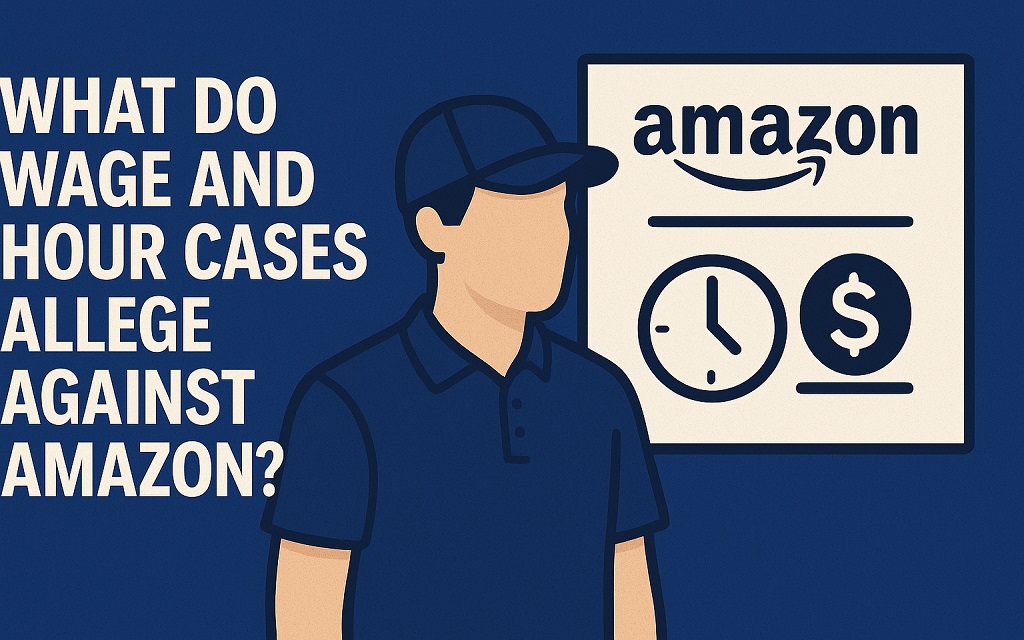
Amazon warehouse workers have filed numerous wage and hour class-action lawsuits, alleging labor law violations under both federal and state laws. The key claims include:
1. Off-the-Clock Work
Plaintiffs argue Amazon requires unpaid time for:
- Security checks before/after shifts
- Prep and transition time are not counted as paid work
- Waiting periods for equipment or instructions
These tasks often total 15–30 minutes per day, adding up to substantial unpaid wages over time.
2. Missed Breaks
Warehouse employees in states like California, Illinois, and New Jersey say Amazon discourages:
- Meal breaks
- Rest periods
- Bathroom access, especially during high-volume seasons
Failure to provide required breaks may lead to penalties per shift under labor codes.
3. Overtime Violations
Amazon allegedly:
- Failed to calculate overtime correctly
- Misclassified some workers as independent contractors (e.g., seasonal delivery drivers)
Class actions in California (Civ. Code §226), Pennsylvania, and Washington highlight these issues. Some cases have settled quietly, while others remain active in court.
If you’re a former or current Amazon warehouse worker, check whether a certified class covers you. Notices will arrive by mail or email, and class periods vary by location and job type.
What Should Amazon Flex Drivers Know About Litigation?
Amazon Flex drivers—independent contractors who use their own vehicles to deliver packages—have also brought class action lawsuits against Amazon over pay, classification, and tips.
1. Tip Misappropriation
In 2021, the FTC fined Amazon $61.7 million for withholding tips from Flex drivers. Internal documents revealed that Amazon altered its pay model to offset base wages with tip money, without informing the drivers. Affected drivers received partial refunds.
2. Worker Misclassification
Multiple lawsuits claim Flex drivers are:
- Treated like employees (set routes, required times)
- But denied benefits like health insurance, minimum wage, or reimbursements
This is the core of misclassification litigation under FLSA and state wage laws.
3. Unpaid Expenses
Flex drivers often pay for:
- Gas and maintenance
- Tolls and phone data
- Parking tickets
Lawsuits say these costs should be reimbursed under laws in California (Labor Code §2802) and Massachusetts.
Many of these cases have moved into arbitration, due to clauses in Amazon’s driver contracts. However, some class actions are advancing, particularly in states with strong gig worker protections.
Tip: If you drove for Amazon Flex between 2016 and 2022 and had withheld tips or out-of-pocket costs, you may be eligible for a separate settlement or state fund relief.
Do Privacy Suits Cover Alexa Voice Data?
Yes. Amazon is facing multiple class-action lawsuits involving its Alexa voice assistant for privacy concerns. Plaintiffs allege that Alexa:
- Recorded conversations without consent
- Captured private or sensitive audio
- Stored data even after users tried to delete it
- Shared or used recordings for training and advertising without permission
Under state wiretap laws (like California’s Invasion of Privacy Act), all parties must consent to recordings. If Alexa was listening even when not activated, Amazon may have violated these laws.
Key Cases & Allegations
- Children’s voice data was allegedly stored indefinitely, violating COPPA
- Amazon allegedly used voice recordings to improve ad targeting
- Alexa devices may have mistakenly activated from ambient speech
Several class actions have been consolidated into multidistrict litigation (MDL), while others proceed separately. Plaintiffs are seeking:
- Injunctive relief to change Amazon’s practices
- Statutory damages for each unauthorized recording
- Deletion of unlawfully obtained data
Amazon denies wrongdoing and says Alexa activates only after wake words like “Alexa” are spoken. It also provides data deletion tools. Courts will decide whether the lawsuits can proceed as nationwide classes.
What Happened With Ring Camera Privacy Claims?
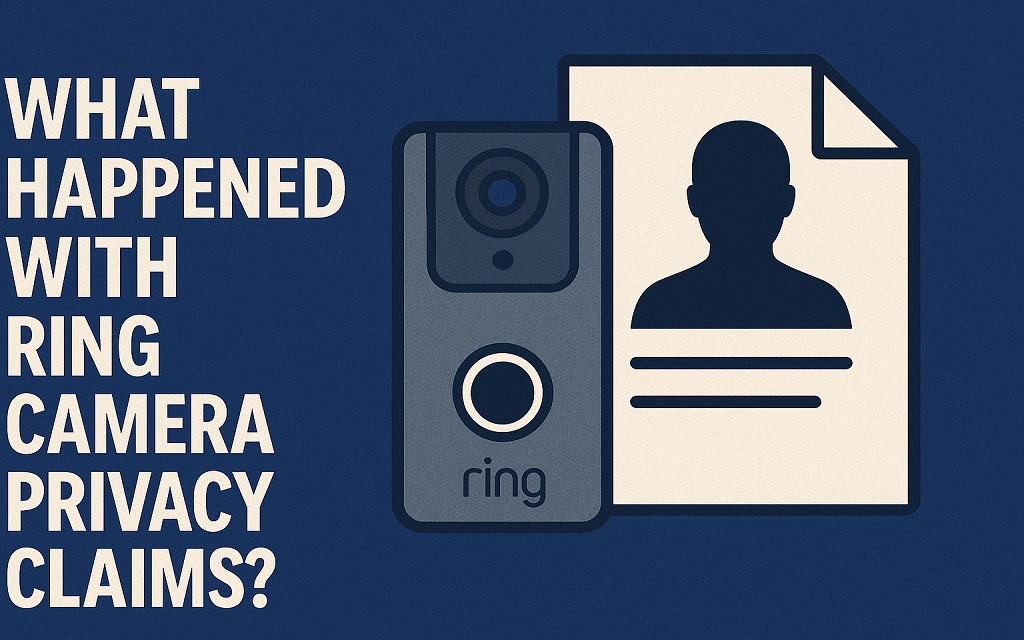
Lawsuits have been filed against Amazon’s Ring doorbell cameras for claimed data exploitation, security flaws, and privacy infringement. These cases focus on:
1. Hacking & Unauthorized Access
Users filed class actions after reports of:
- Hackers accessing live video feeds
- Two-way talk features are used for harassment
- Lack of proper encryption and authentication
Amazon responded by adding mandatory two-factor authentication, but plaintiffs claim damage was already done.
2. Law Enforcement Data Sharing
The Ring allowed law enforcement access to footage without proper warrants or consent. This raised concerns about:
- Fourth Amendment violations
- Surveillance creep
- Lack of user control over stored video
3. Employee Misuse of Data
Some lawsuits allege Ring employees accessed private videos without authorization. In one case, engineers watched footage of indoor cameras beyond their intended scope.
By 2024, several class action settlements that provided compensation to users impacted by security breaches will have been authorized. There are still other cases outstanding, such as fresh grievances over AI-powered facial recognition and motion detection.
If you have a Ring device between 2016 and 2023, you might be eligible for:
- Payouts for settlements
- Free device replacements or upgrades
- Compensation for privacy
Do Plaintiffs Contest Biometric Scans Under BIPA?
Yes. Under Illinois’ Biometric Information Privacy Act (BIPA), one of the strongest privacy laws in the country, Amazon has been the target of multiple class-action lawsuits. According to these lawsuits, Amazon:
- Collected facial scans through Amazon Go stores and Ring cameras
- Captured voiceprints via Alexa-enabled devices
- Failed to obtain written consent before collecting or storing biometric data
- Did not publish clear policies for data retention and destruction
Under BIPA, companies must:
- Notify users before collecting biometric data
- Secure written consent
- Allow users to access, delete, or prevent use of their biometric identifiers
Plaintiffs allege that Amazon’s systems use facial mapping, hand geometry, and voice analysis without user permission. For example:
- Ring’s facial recognition tools may tag individuals in recorded footage
- Amazon Go stores track shoppers using facial surveillance and gait recognition
- Alexa voice assistants potentially capture voice biometrics
Damages in class actions might increase quickly because BIPA violations can result in statutory damages of $1,000 to $5,000 for each violation.
Amazon refutes these allegations, stating that it provides consumers with opt-out choices and anonymizes data. Courts have, however, let many BIPA cases move past the request to dismiss stage, indicating that there is a genuine legal risk.
Verify whether your biometric information was taken without your knowledge if you used Amazon Go, Alexa, or Ring devices in Illinois. You may be part of a BIPA-related class action or entitled to future relief.
How Do Seller Antitrust Cases Describe Marketplace Rules?
Amazon sellers have also filed class action lawsuits alleging the company’s Marketplace policies are anticompetitive. These cases argue that Amazon:
- Imposes excessive fees on sellers—often up to 50% of total sales
- Forces sellers to use Amazon’s own fulfillment services to access the Buy Box
- Bans sellers from offering lower prices on competing platforms
- Controls pricing indirectly through penalties and search suppression
A central legal issue is whether Amazon’s policies create a “monopoly over its own marketplace” and use that power to extract unfair terms from small sellers.
Seller claims include:
- Tying: Sellers must buy one service (FBA) to get another (Buy Box visibility)
- Price fixing: Through rules that prevent lower prices elsewhere
- Exclusive dealing: Sellers discouraged from multichannel distribution
- Abuse of market power: Amazon’s dominant market share forces sellers to comply or lose income
With the help of inside information on pricing, demand, and performance, sellers also claim that Amazon unfairly competes with them directly by employing private-label brands.
In accordance with Section 2 of the Sherman Act, the FTC and several state attorneys general are also looking into these activities.
Sell products on Amazon and experienced platform restrictions, unfair fee increases, or sales suppression due to pricing decisions. You may have legal standing to join a class action lawsuit focused on the seller.
What Proof Is There for Tying or Monopoly Theories?
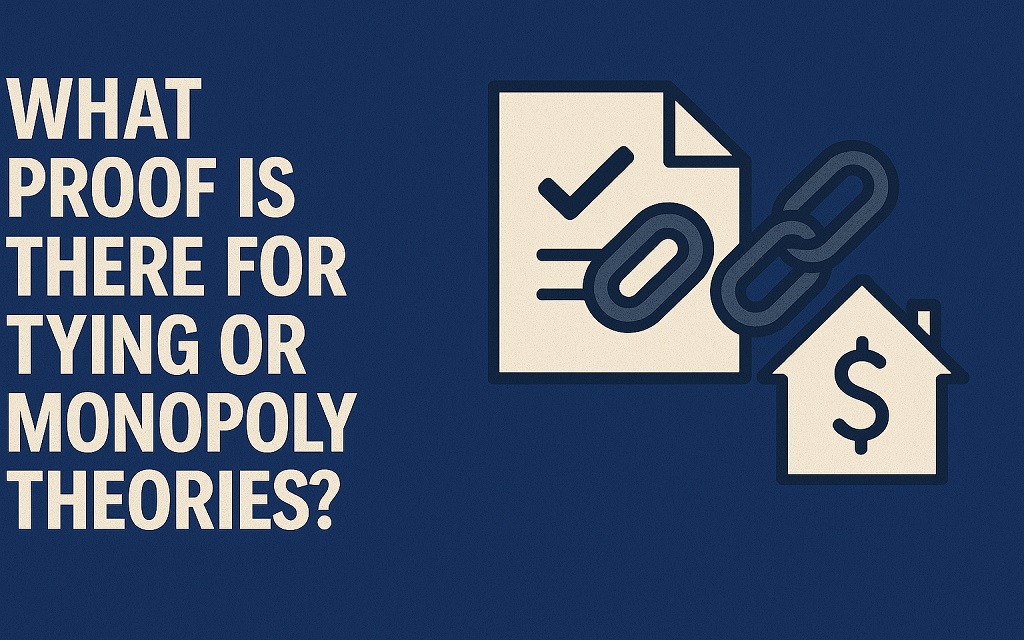
Economic models, internal papers, and pricing data are used by antitrust plaintiffs—including sellers and consumers—to bolster allegations of monopoly power and tying violations by Amazon.
Here’s what they present as evidence:
1. Market Dominance
Amazon controls:
- Over 38% of U.S. e-commerce
- The top platform for product search (even above Google)
- The most powerful logistics platform in online retail (via FBA)
Antitrust liability requires a monopoly or near-monopoly status, which is suggested by this degree of control.
2. Restrictive Seller Agreements
Court filings and leaked Amazon policies show:
- Sellers risk suspension for offering lower prices elsewhere
- Buy Box access is tied to using Fulfillment by Amazon (FBA)
- Sellers have limited power to negotiate fees or terms
This creates a potential tying arrangement where access to key services (like visibility or shipping) is conditioned on the purchase of other Amazon products.
3. Price Effects on Consumers
Plaintiffs present expert testimony showing:
- Artificial price floors across e-commerce
- Suppressed competition among retailers
- Elevated costs for identical goods on Amazon vs. other platforms
According to internal communications, Amazon periodically penalized sellers who violated price parity by using strategies like algorithmic suppression or demotion.
Together, these elements provide the foundation for claims of monopolistic abuse and tying, which are crucial for both private lawsuits and government enforcement measures.
What Defenses Does Amazon Raise in These Cases?
Amazon has consistently denied wrongdoing in every significant class action and regulatory challenge. Its core legal defenses include:
1. Consumer Benefit
Amazon argues its policies:
- Lead to lower prices, not higher
- Ensure customer trust and a consistent experience
- Are pro-competitive, not anti-competitive
For example, Amazon’s legal pleadings state that the Buy Box algorithm “promotes quality fulfillment” and that price parity regulations assist in “keeping Amazon’s prices competitive.”
2. Marketplace Status
Amazon claims to be:
- A platform provider, not a direct seller (in many cases)
- Offering tools and exposure—not controlling how sellers operate
- Subject to market competition from Walmart, eBay, Target, and Shopify
This helps Amazon argue it doesn’t hold monopoly power under antitrust law.
3. Voluntary Participation
Amazon notes that:
- Sellers choose to list on its platform
- Shoppers have alternatives
- Fulfillment services are optional—though incentivized
This defense is designed to counter claims of coercion or tying.
4. Lack of Commonality
In class actions, Amazon often argues:
- Users had different experiences
- Pricing varied by product and time
- Class treatment is unmanageable
This argument was rejected in the De Coster case, but Amazon has appealed, showing it remains a central strategy.
What Impact Do Arbitration Clauses Have on Class Action Cases?
Arbitration clauses are found in many of Amazon’s user and seller agreements, which may limit an individual’s ability to participate in class actions. Here’s how arbitration affects legal strategy:
1. What Is Forced Arbitration?
It’s a private legal process where:
- Claims are resolved outside of court
- No jury trial or public decision occurs
- Individuals waive class action rights
Amazon inserts arbitration terms into:
- Prime user agreements
- Seller central terms of service
- Flex driver contracts
2. How It Impacts Class Certification
Arbitration clauses often:
- Prevent class-wide relief
- Force plaintiffs to file one-by-one claims
- Slow litigation progress
In some Amazon cases, courts have upheld arbitration. In others, courts have ruled:
- Amazon’s terms are unconscionable or unenforceable
- Arbitration doesn’t apply to specific state law claims
- Mass arbitration may still proceed with aggregated outcomes
3. Current Legal Trends
Courts are increasingly skeptical of arbitration clauses that:
- Lack clear opt-in consent
- Apply retroactively
- Limit statutory rights
Some Amazon cases now specifically target arbitration agreements, arguing that they impede public accountability and equitable legal access.
Review the most recent court rulings as a guide. Opt-out or carve-out alternatives may still be available if a class action lawsuit affects you and Amazon claims you accepted an arbitration agreement.
What Does Federal Court Class Certification Require?
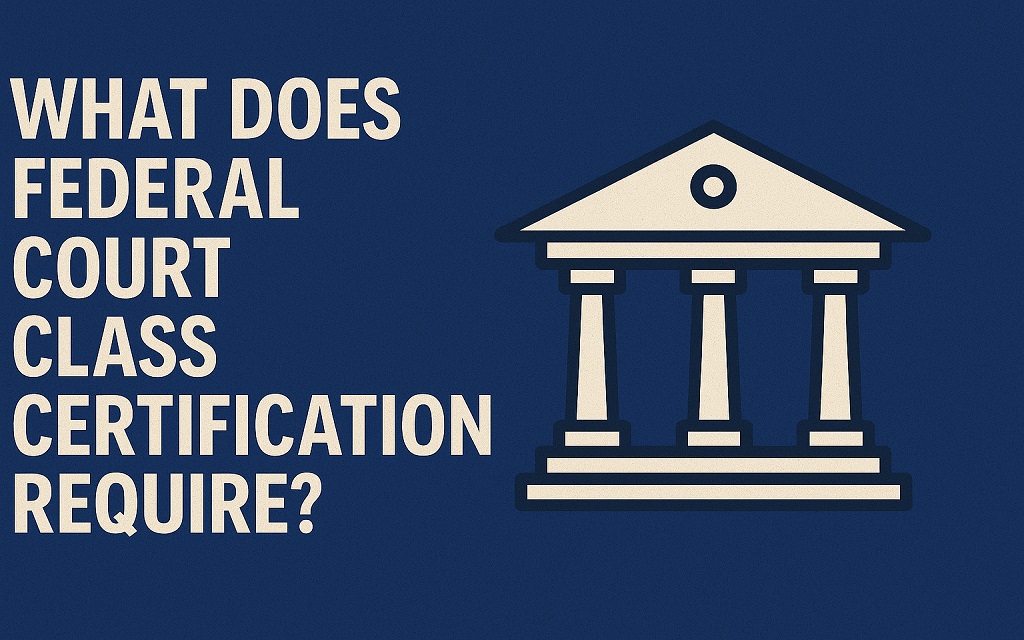
To continue as a class action, a case must meet the strict legal conditions specified in Federal Rule of Civil Procedure 23. In the De Coster v. Amazon case, a federal judge found that the plaintiffs met these requirements.
Key elements of Rule 23:
- Numerosity
The class must be so large that individual lawsuits are impractical. In the Amazon case, the court certified a class of nearly 288 million U.S. consumers—clearly satisfying this criterion. - Commonality
There must be questions of law or fact common to the class. Here, the standard issue was whether Amazon’s pricing restrictions artificially inflated consumer prices. - Typicality
The lead plaintiffs’ claims must be typical of the class. The consumers in this case all made purchases from third-party sellers, allegedly affected by Amazon’s price control policies. - Adequacy of Representation
The plaintiffs must fairly and adequately protect the interests of the class. The court found the plaintiffs and their legal teams competent and committed. - Predominance and Superiority (Rule 23(b)(3))
Common issues must predominate over individual ones, and a class action must be more efficient than many individual lawsuits.
Amazon’s Opposition
Amazon argued:
- The class was too large and too diverse
- Pricing varied too much across users
- Class treatment would be unmanageable
But Judge John Chun rejected these arguments, noting that other courts have approved similarly large classes and that the core economic question was shared across all members.
How Do Settlements Work in Amazon Cases?
When class action cases don’t go to trial, they often end in a settlement. This involves Amazon agreeing to pay money or change business practices—without admitting guilt.
Here’s how the settlement process works:
1. Negotiation and Agreement
Both parties negotiate a settlement fund. This may include:
- Cash compensation for affected users or sellers
- Changes to Amazon policies
- Attorney fees and administrative costs
2. Preliminary Approval
The judge reviews the proposed settlement to ensure it’s fair, reasonable, and adequate. This triggers a notice period, where class members are informed.
3. Claim Submission
Eligible users must:
- Complete a claim form
- Submit documents (if required)
- Do so before the deadline
Amazon may occasionally use past purchases to make automated payments, particularly if it already has the required customer information on file.
4. Objections and Opt-Outs
Class members can:
- Object to the terms
- Opt out if they want to sue Amazon individually
5. Final Approval
The court either accepts or rejects the agreement during a public hearing. After approval, the lawsuit is settled, and payouts start.
Settlements typically take six to eighteen months to complete. Administrative problems or appeals may cause delays in high-value cases.
How Much Do Class Members Usually Receive?
Payouts in Amazon class actions vary widely based on:
- The size of the settlement fund
- The number of valid claims submitted
- The level of proof required
- The specific harm alleged (financial loss, data breach, labor violation)
Here are typical ranges:
| Case Type | Average Payout |
|---|---|
| Prime auto-renewal refund | $5 – $25 |
| Alexa privacy settlement | $15 – $50 |
| Ring camera breach claims | $20 – $100 |
| Third-party seller price lawsuit | TBD (potentially $50+ per user) |
| Flex driver tip lawsuit (FTC) | $20 – $600 |
In some lawsuits (like the FTC tip settlement for Flex drivers), payouts reached hundreds of dollars per person. In others, like small consumer claims, it’s often under $30.
Keep in mind:
- Fewer valid claims = higher payout per person
- You may need to show purchase dates, order numbers, or account details
- Some settlements distribute money via PayPal, direct deposit, or check
The ultimate settlement amount, if the case is still pending, won’t be known until the court accepts a settlement or the case is tried and won.
Must Read: Cash App Settlement Lawsuit in Washington – $12.5M Fund, Who Qualifies, How to File
How Much Time Is Needed for Amazon Class Actions?
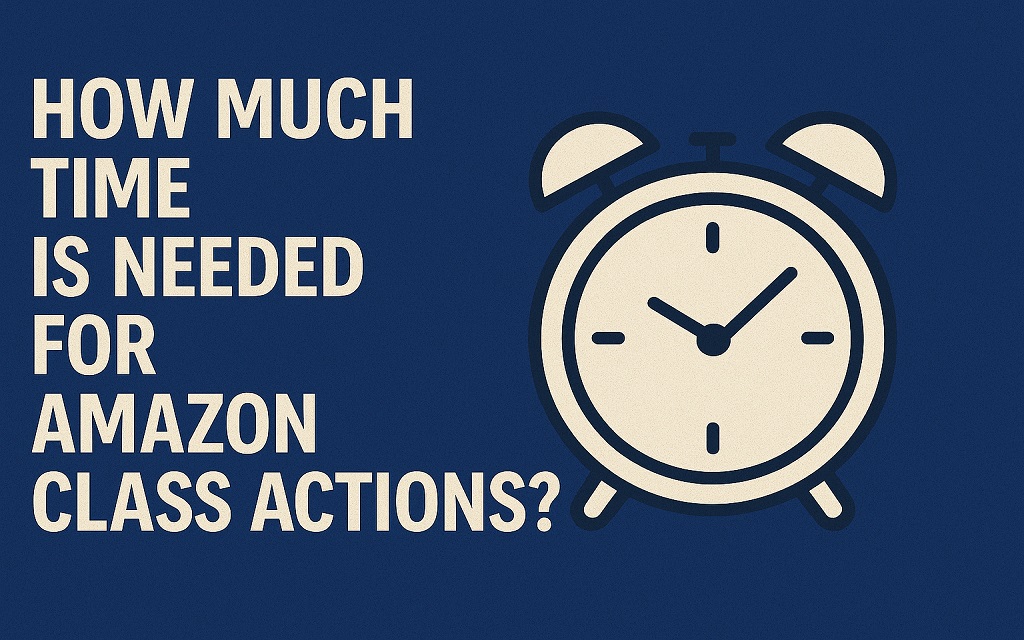
Class actions against Amazon—large ones—involve multiple phases, often spanning several years.
General Timeline:
- Filing (Year 1)
A complaint is filed in federal court. - Motions to Dismiss (Year 1–2)
Amazon tries to block the lawsuit early. If denied, discovery begins. - Discovery and Class Certification (Year 2–3)
Both sides exchange evidence. Plaintiffs ask for class status. Amazon may appeal. - Appeals (Year 3–4)
If class status is granted, Amazon often appeals immediately. - Settlement Talks or Trial Prep (Year 4–5)
Parties may negotiate or prepare for court. - Settlement Approval or Trial Outcome (Year 5+)
If a settlement is reached, the payout process begins. If not, trial results determine the outcome.
The De Coster case, for example, was brought in 2021. It has just attained class certification as of September 2025, and an appeal is probably going to last until 2026 or later.
Summary:
- Fast cases resolve in 1–2 years (e.g., small refund settlements)
- Complex antitrust cases may take 5–7 years
- Appeals can add delays
Patience is key. Class action sites and official settlement portals offer updates as cases progress.
How Do You Check If You Qualify for a Payout?
To know if you’re eligible for money in an Amazon class action or settlement, follow these steps:
1. Review the Class Definition
Look at:
- Purchase or employment dates
- Product or service involved
- Location (U.S. vs. specific state)
- Type of transaction (e.g., third-party seller purchases)
For example, in the De Coster case:
You qualify if you bought five or more new items from third-party sellers on Amazon.com after May 26, 2017.
2. Check Official Settlement Websites
These are created after court approval. They include:
- Claim instructions
- Eligibility requirements
- Deadlines and contact info
Official domains usually end in .com or .org And are linked on:
- FTC.gov
- ClassAction.org
- Court records
3. Search Email or Mail Notices
Courts often approve direct notice campaigns. If your email or physical address is on file with Amazon, you may receive:
- A Notice of Settlement
- Claim code or class ID
- Instructions on next steps
4. Gather Proof (if needed)
This could include:
- Amazon order confirmations
- Email receipts
- Account login info
- Screenshots of purchases or messages
Documentation is not necessary for every settlement, but it might expedite your claim or boost your reward.
How Can an Amazon Settlement Claim Be Filed?
Although submitting a claim in an Amazon class action is typically straightforward and cost-free, you must adhere to formal guidelines and take action before the deadline.
Step-by-Step Claim Process:
Locate the Official Claims Website
Once a court approves the settlement (preliminary or final), the administrator launches a website. It includes:Settlement details
Claim form link
Contact for help
Tip: Always double-check the website—reputable URLs are frequently identified on ClassAction.org, FTC.gov, or in court notices themselves.
Complete the Claim Form
Most forms ask for:Full name
Email and mailing address
Purchase or user history (Amazon order dates or types)
Claim ID (if one was issued in a mailed or emailed notice)
Upload Supporting Documents (if required)
Some settlements accept claims with:Amazon order confirmations
Screenshots from your account
Proof of Prime subscription or Ring camera ownership
Flex driving schedule summaries
Other settlements use Amazon’s internal records to verify eligibility—no upload required.
- Submit Before the Deadline
You will not be compensated if you miss the deadline. Set calendar reminders or bookmark the claims website. - Track Confirmation
After submitting, save your screenshot or confirmation number. This is beneficial in the event of disagreements or follow-up inquiries.
What Deadlines Should You Track for Claims and Opt-Outs?
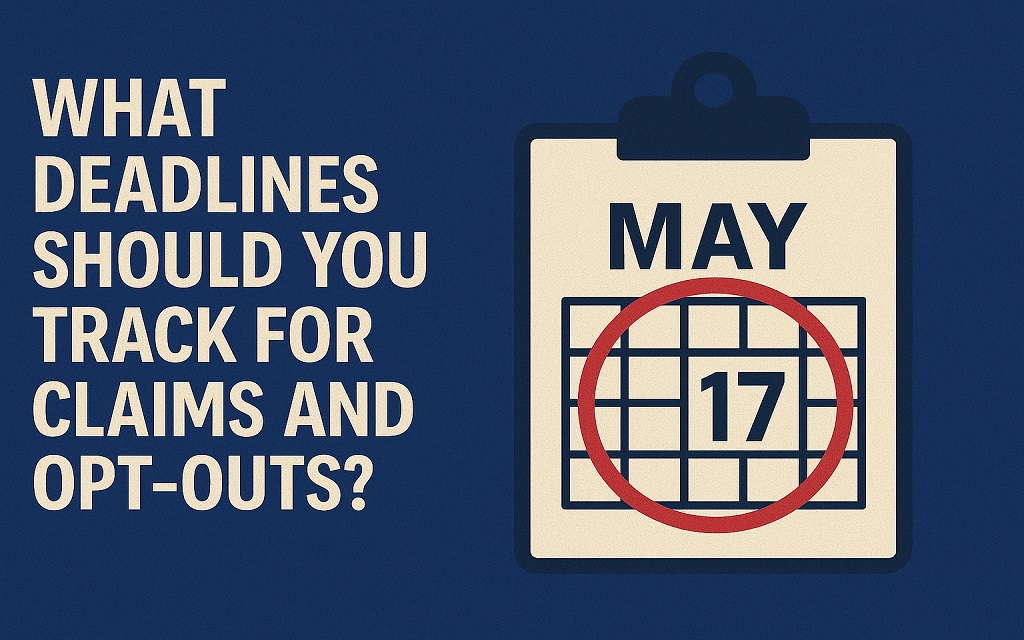
Deadlines in Amazon class actions are critical. Missing one can mean you lose your right to receive a payout or bring your own lawsuit.
Key Legal Deadlines:
Claim Filing Deadline
This is the final date to:Submit a claim form
Upload documentation
Correct any errors
It typically takes 60–120 days after the preliminary approval notice.
Opt-Out Deadline (Exclusion)
If you don’t want to be part of the class—because you plan to sue Amazon yourself—you must formally opt out.
This deadline is usually earlier than the claim deadline.
To opt out:
Send a signed letter with your name, address, and case reference
Clearly state your request for exclusion
Postmark it by the stated deadline
Objection Deadline
If you want to stay in the class but disagree with the terms, you can submit an objection. This involves:A written statement
Reasons for your objection
Often, a court appearance (optional)
Final Approval Hearing Date
The court holds a hearing to:Review fairness
Consider objections
Approve or reject the deal
No payouts happen until this is complete.
Where to find deadlines:
- On the settlement site homepage
- In notices sent via email or mail
- In court documents filed online
What Documents Help Prove a Valid Claim?
Although many Amazon class action settlements verify purchases internally, having your own records strengthens your case—and increases your payout accuracy.
Recommended Documents:
Amazon Order Confirmations
Found in:Emails from “[email protected]”
Your Amazon order history page
Invoices or Receipts
Especially important for:Business accounts
Sellers or drivers claiming expenses
Screenshots of Product Pages
If a claim involves false advertising, pricing disputes, or subscription terms, screenshots can be helpful.Email Notices from Amazon
For cases involving:Prime subscriptions
Alexa or Ring disclosures
Flex driver pay adjustments
Proof of Identity
Sometimes required to prevent fraud:Government ID (rare)
Address verification (utility bill)
Account Login Screens
Useful if:You’ve lost access to your original Amazon account
You’re filing under an old email
Tip: Log in to your Amazon account and go to:
Your Orders → Filter by Year → Download Invoice or Screenshot
Save these in PDF format for easy upload when claim forms open.
How Do Taxes Work on Settlement Payments?
Most Amazon class action payments are small consumer refunds and not taxable. But there are exceptions depending on the type and size of the payout.
Tax Basics for Settlements:
Consumer Purchase Refunds
If you’re getting money back for overcharges or subscription fees, the IRS generally treats it as non-taxable. It’s simply returning money you already spent.
Examples:
- Prime auto-renewal refunds
- Overpricing on third-party seller purchases
Wage Settlements (Workers/Flex Drivers)
If the money relates to:Unpaid wages
Missed overtime
Reimbursement for hours worked
Then it is usually considered taxable income. You may receive a 1099 or W-2, depending on the size and type of payment.
Injury or Privacy-Based Claims
Payments related to:Privacy violations (e.g., Alexa or Ring lawsuits)
Emotional harm or statutory damages
These can be a gray area. If the payout is substantial, consider consulting a tax professional.
Attorney Fees
If you’re not directly paying legal fees (in class actions, you usually aren’t), they don’t affect your taxes.
Summary:
| Type of Payment | Taxable? |
|---|---|
| Consumer refund | ❌ No |
| Wage settlement | ✅ Yes |
| Privacy damages | ⚠️ Maybe |
| Expense refund | ❌ No |
When in doubt, the settlement website FAQ often clarifies the tax treatment—or you can request a 1099-MISC from the claims administrator.
How Do These Lawsuits Affect Amazon Customers?
Class actions help enforce consumer rights—even if the payouts are small. Here’s how they’re impacting Amazon shoppers:
1. Lower Prices and Competitive Reforms
Antitrust cases may force Amazon to:
- Drop restrictive pricing rules
- Allow sellers to compete on price
- Reduce take-rates and fees, potentially lowering retail costs
This gives customers more access to cheaper goods across platforms.
2. Clearer Subscriptions and Renewals
Following lawsuits over Prime auto-renewal, Amazon simplified its cancellation process and clarified trial terms—especially for mobile users.
New ARL-compliant interfaces mean fewer surprise charges.
3. Better Data Privacy
Alexa and Ring lawsuits pushed Amazon to:
- Add more privacy toggles
- Offer data deletion tools
- Restrict employee access to user footage
You now have more control over how your data is used.
4. Refund Opportunities
Customers who never expected compensation are receiving refunds through settlements—even small ones. Signing up ensures your voice is counted in corporate oversight.
5. Transparency in Policies
Litigation has exposed Amazon’s previously undisclosed internal tactics, such as the employment of algorithms to penalize merchants or raise pricing. As this comes to light, Amazon faces increased public scrutiny and accountability.
In short, lawsuits may seem slow, but they’re already changing how Amazon operates—for the benefit of its customers.
What Do Lawsuits Mean for Amazon Workers and Drivers?
Class-action lawsuits are prompting Amazon to reform its labor practices, particularly for warehouse workers and Flex drivers.
1. Wage Transparency and Break Compliance
Lawsuits alleging unpaid time, missed breaks, and uncompensated security screenings have led to:
- Better clock-in/out systems
- Posted break policies at fulfillment centers
- Internal audits to address labor law compliance
In some regions, Amazon has agreed to settlements with back pay, especially in California and New York.
2. Tip Recovery for Flex Drivers
The $61.7 million FTC settlement in 2021 forced Amazon to return tips withheld from Flex drivers. Class actions continue to pursue:
- Compensation for unpaid miles
- Gas and maintenance reimbursements
- Worker misclassification correction
Some cases seek reclassification of Flex drivers as employees, which could unlock health benefits and overtime protections.
3. Safer Working Conditions
While not always tied directly to lawsuits, legal pressure has coincided with:
- New warehouse safety technology
- Heat mitigation protocols
- Reduction of peak-season quotas in select states
In conclusion, class actions give employees the legal clout they wouldn’t otherwise have. These lawsuits, whether filed in federal court or arbitration, are altering Amazon’s personnel management practices.
How Do Third-Party Sellers Get Affected by Cases?

For third-party sellers on Amazon Marketplace, class actions may mark a turning point in the extent to which Amazon can legally exert control over pricing, visibility, and fees.
1. Fee Structures Under Scrutiny
Multiple lawsuits allege Amazon:
- Charges up to 50% of each sale through combined fees
- Raises costs without adequate notice
- Penalizes sellers for listing lower prices on other sites
Legal pressure may prompt fee caps or greater transparency.
2. Algorithm Fairness
Class actions challenge the Buy Box algorithm, claiming it rewards Amazon-preferred practices (like using Fulfillment by Amazon) rather than price or service quality. A win for plaintiffs may:
- Force Amazon to publish algorithm rules
- Level the playing field for smaller sellers
3. Private-Label Competition
Some sellers’ claims highlight Amazon’s practice of:
- Copying top-selling products
- Launching private-label versions
- Undercutting prices using internal performance data
Lawsuits push to separate platform ownership from product competition, a significant shift in e-commerce strategy.
Sellers who’ve been de-ranked, delisted, or overcharged may benefit from future settlements or join existing antitrust litigation.
What Is the Outlook for Future Amazon Litigation?
Amazon’s legal troubles are far from over. In fact, experts predict more class actions and regulatory cases across several key areas.
1. FTC Antitrust Trial (2027)
The Federal Trade Commission’s lawsuit against Amazon, which focused on algorithmic pricing and market dominance, is set for trial in February 2027. A ruling in favor of the FTC could:
- Split Amazon’s business units
- Ban certain seller restrictions
- Led to record-breaking penalties
2. Ongoing Consumer Class Actions
More lawsuits are expected around:
- Subscription models (Prime, Audible, Kindle Unlimited)
- Dark patterns and deceptive cancellation flows
- Return policy changes affecting refunds
3. Privacy and AI Cases
As Amazon rolls out AI-powered shopping, home surveillance, and Echo devices, it opens itself to:
- New BIPA lawsuits
- Facial recognition regulation
- Biometric data storage litigation
4. State-Level Enforcement
Attorneys general in California, New York, and Washington continue to coordinate multistate actions. They are targeting:
- Consumer fraud
- Deceptive marketing
- Environmental disclosures in logistics
With scores of pending cases in both federal and state courts, Amazon’s legal concerns now include antitrust, labor law, privacy, and advertising.
Where Can I Find Official Notices and Updates?
Staying informed is key if you’re a class member or want to track your eligibility. Use only verified legal and government sources for updates.
Trusted Sources for Updates:
FTC.gov
The Federal Trade Commission posts:Active lawsuit summaries
Official refund portals
Notices of consent orders or settlements
👉 https://www.ftc.gov
ClassAction.org
Offers:Settlement claim forms
Eligibility checklists
Lawsuit alerts by product or company
👉 https://www.classaction.org
Official Settlement Sites
These domains often include the case name:amazonclasssettlement.com
primeautoreneewalsettlement.com
ringdataclassaction.com
Check the site footer for contact info and court approval details.
Court Dockets (PACER or Justia)
For in-depth legal filings and motion updates:
👉 https://www.pacer.gov
👉 https://dockets.justia.comLaw Firm Pages
Reputable class action firms like Hagens Berman or Keller Rohrback often host:Case updates
Opt-out instructions
FAQs for affected users
Tip: Bookmark the settlement site if you’ve already filed a claim. You can log in later to check payment status.
Glossary of Class Action and Legal Terms
You can better follow the case and defend your rights if you are familiar with the terms. Here are standard terms used in Amazon’s class action lawsuits:
| Term | Meaning |
|---|---|
| Class Action | legal action taken by one or more individuals on behalf of a larger group of people who have identical claims. |
| Plaintiff | The plaintiff is the individual or organization that files the lawsuit. |
| Defendant | The defendant, Amazon, is the party being sued in this instance. |
| Class Certification | Permission from the judge to handle the matter as a class action. |
| Claim Form | The form you submit to receive payment is referred to as a claim form. |
| Opt-Out | The choice to withdraw from the course while maintaining the ability to litigate as an individual. |
| Arbitration Clause | A clause in a contract that can mandate that disagreements be resolved out of court and privately. |
| Settlement | An agreement to settle the issue without acknowledging wrongdoing, usually with payment. |
| Final Approval | A judge’s decision to officially accept a class action settlement. |
| BIPA | Biometric Information Privacy Act, a strict Illinois privacy law. |
Tip: You can get in touch with the settlement administrator indicated on the official claims website if you’re having trouble understanding a court notice.
Conclusion: What you should know
Amazon is dealing with a growing variety of legal problems, from price rules and subscription renewal disputes to worker rights and privacy issues. Holding the company accountable and compensating affected drivers, retailers, and consumers are the goals of these class actions.
If you have interacted with Amazon in any of the ways mentioned above, confirm your eligibility, keep an eye on claim deadlines, and stay informed. Even little settlements can make a difference, and when they add up, they help create a fairer online economy.
Disclaimer: This article provides a general overview of the Amazon Class Action lawsuit, based on publicly available information, and is intended for informational purposes only. It is not legal advice.

